When CBGB closed its doors in 2006, 70s punk icon Patti Smith sagely remarked, “There’s new kids with new ideas all over the world. They’ll make their own places—it doesn’t matter whether it’s here or wherever it is.” The words are calm, rational, and wise—but ten years later, they don’t soothe the sting of walking past 315 Bowery and seeing the grungy white awning and caked-on graffiti replaced by a John Varvatos outlet.
Photographers James and Karla Murray have been documenting the changing atmosphere of New York City for two decades—their photos are the source material for Randy Hage’s highly-detailed dioramas of old New York. They’ve published their work in three books called Store Front, Store Front II, and New York Nights, immortalizing the unique 19th and 20th century graphics that enticed NYC shoppers for generations. They snap images of each building and supplement them with interviews of the enchanting personalities behind the businesses. Personalities like former Katy’s Candy Store owner, Katy Keyzer, who told them, “I speak 3 languages. English. Spanish. And Motherfucker.” Her shop closed in 2007, the year after CBGB.
Videos by VICE
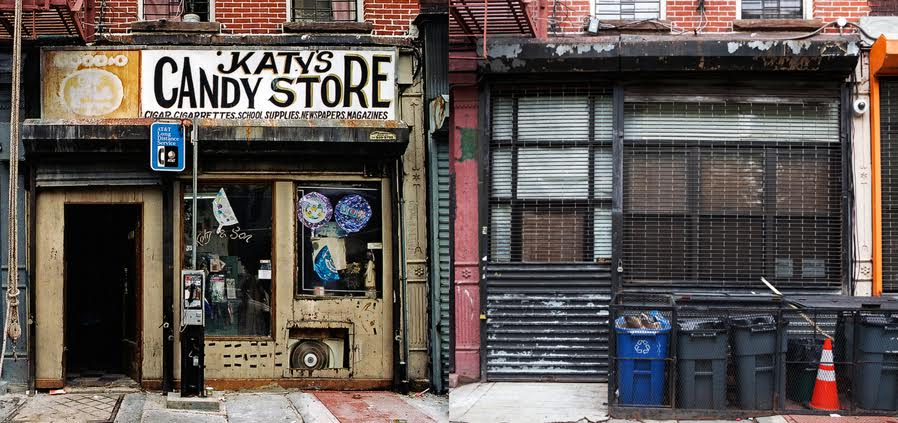
Katy’s Candy Store- Bedford-Stuyvesant, Brooklyn (2004) left/ right (2014) Katy’s Candy opened in 1969 and was one of the last penny candy stores in NYC. Katy Keyzer famously told us , “I speak three languages, English, Spanish, and Motherfucker. You’ve got to be tough to survive in this neighborhood.”. Unfortunately she was forced to close in 2007 when the landlord tripled her rent and the store has remained empty to this day.
At first, the Murrays didn’t want to make a before-and-after comparison book because the visuals were too painful. “We had developed such a personal connection and in many times a friendship with the store owners after spending many hours photographing their store and speaking with them,” the couple tells The Creators Project. “However, we did notice very early on while photographing the original stores that if the owner did not own the entire building, their business was already in jeopardy of closing. The owners themselves frequently acknowledged that they were at the mercy of their landlords and the ever-increasing rents they charged.”
However, they inevitably wound up capturing the changing storefronts over the years. They documented the transformation from CBGB to John Varvatos, Katy’s Candy Store to vacant retail space, and innumerable pharmacies, delis, and record stores into banks and Starbucks locations. “By the time we wrote our introduction to our book Store Front: The Disappearing Face of New York in 2008, over one-third of the stores we had photographed had already disappeared and today, over two-thirds are no longer in business,” they say.
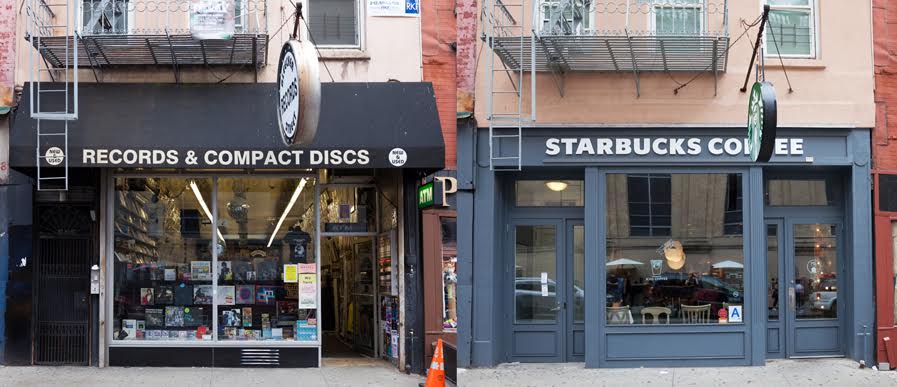
Bleecker Street Records was forced out of its storefront on Bleecker Street after 20 years in business, by a steep rent increase that would have required the store to pay $27,000 a month in rent. A Starbuck’s soon moved into the space. Photo left 2001/ photo right 2015.
Right now they’re working on a new book called Mom & Pop: Erasing New York’s Family-Owned Shops. “We felt strongly that because these storefronts were rapidly disappearing at such a fast pace in the face of modernization and conformity, that the once unique appearance and character of New York’s colorful streets was suffering in the process,” the couple says.
They are admirers of the photography of Berenice Abbot, a 1930’s WPA beneficiary who documented New York’s tranformation from distinguished port into towering city of the future. In 2004, Douglas Levere published a book revisiting the same iconic places as Abbot—a compelling continuation of the narrative she began. By similarly re-photographing all the locations they had documented since the late 90s, the Murrays also continue the city’s narrative.

Mars Bar East Village (2005) / TD Bank branch (2015) Mars Bar, one of the East Village’s last remaining dive bars closed in 2011 after the building it was located in was sold and replaced by a 12-story luxury apartment rental building.
“The purpose of the photos in Mom & Pop is to clearly spell out and provide documentation of not only what storefronts have been lost but also what is often lacking in the commercial space’s replacement,” they explain. This is also the mission of photographers like Levere and Paul Sahner, Reddit’s /r/nycpics forum, plus countless Facebook groups like Dirty Old 1970’s New York City and Manhattan Before 1990. “Until you place them side-by-side and really look at the two photos, you cannot get the true sense of loss experienced by the neighborhood,” the Murrays continue. “We hope this glimpse will bring awareness to the unique character these small mom-and-pop businesses add to the streets and neighborhoods of New York City and the sense of community they provide.”
These businesses are caught in the crossfire of gentrification, and the cacophonous conversation about whether it’s a tragedy that must be stopped or an inevitable, harmless economic phenomenon. Regardless of your philosophy, take a moment to appreciate the unstoppable march of time these images represent. Reject or embrace the march, it’s fascinating to see it summarized in a single image.
James and Karla Murray have been working on Mom & Pop: Erasing New York’s Family-Owned Shops for the past year and a half. They have given us images and captions from the book, which you can peruse above and below.

The 2nd Avenue Deli was opened in the East Village in 1954 by Abe Lebewohl, a Jewish immigrant from Russia. Abe Lebowohl was murdered in 1996 during a robbery after the restaurant had closed for the night. Abe’s brother Jack took over the deli after Abe’s death but was forced to close in 2006 after the rent was increased from $24,000 a month to $33,000 a month. A Chase Bank branch took over the space. Photo left 2005 / photo right 2015.
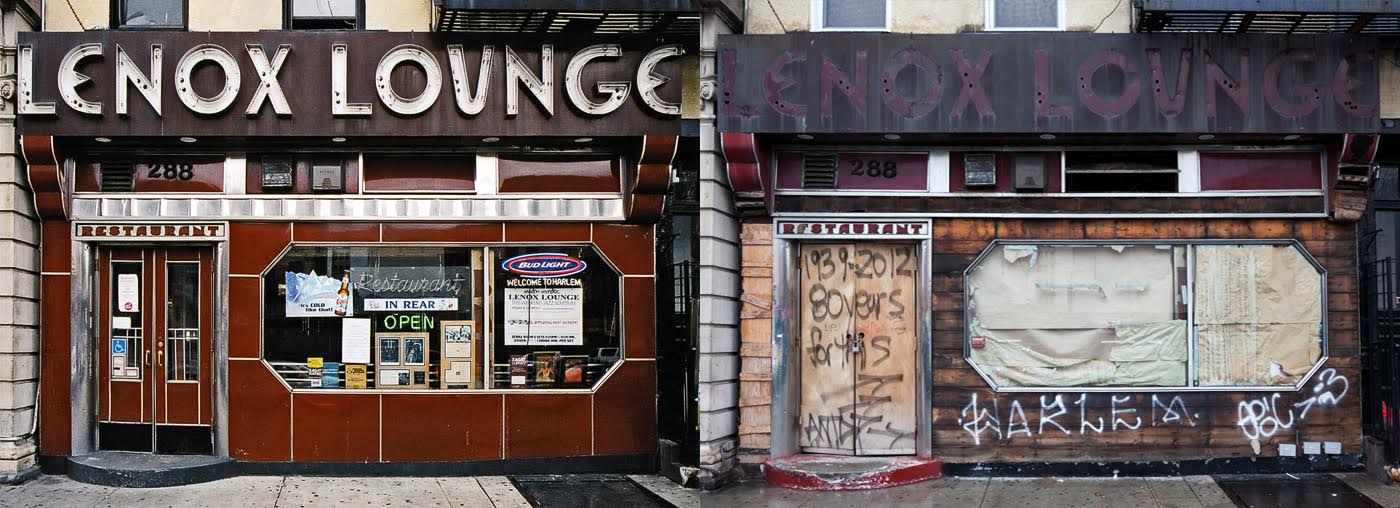
Lenox Lounge closed on December 31, 2012 after 73 years in Harlem, when the landlord doubled the rent from $10,000 to $20,000 per month, forcing it out of business. Jazz greats Billie Holiday, John Coltrane and Miles Davis all performed at Lenox Lounge and many political luminaries including Langston Hughes, James Baldwin and Malcolm X gathered there. Alvin Reed, who had purchased the lounge in 1988 and brought back live jazz performances and restored much of its interior, plans to reopen again. Photo left 2004 / photo right 2014.

Lismore Hosiery Co. Grand Street, Lower East Side (2004)/ Subway (2014) Lismore Hosiery was in business for over 68 years before it closed in 2005. The owners lost their lease when the building it was located in was sold to a condo developer.
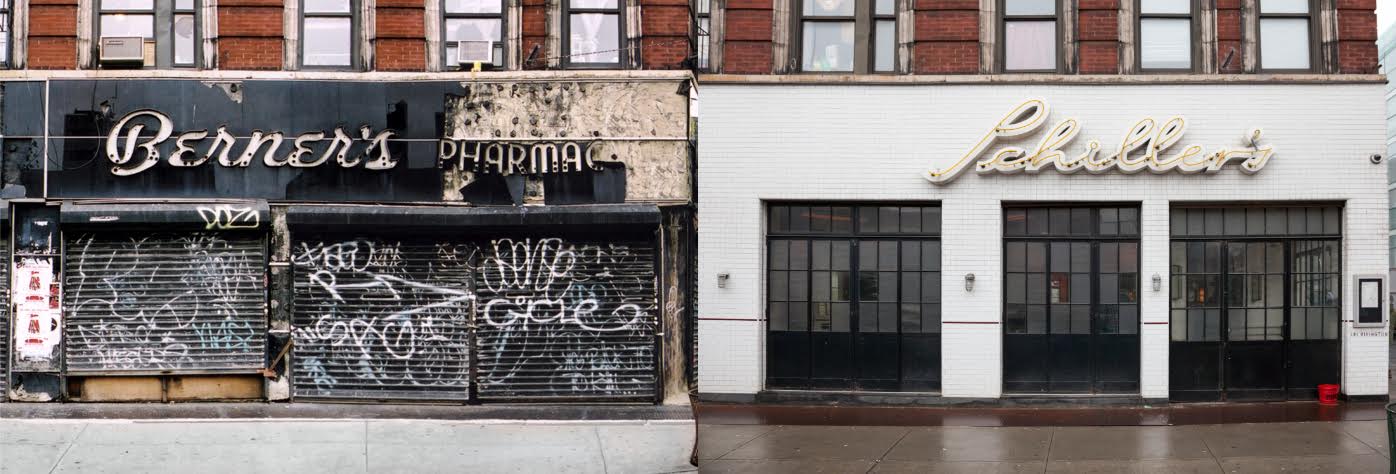
Berner’s Pharmacy- Rivington Street, Lower East Side (1999)/ Schiller’s Liquor Bar (2014) Berner’s Pharmacy was closed for a long time and covered in tags before being renovated into Keith McNally’s trendy restaurant Schiller’s Liquor Bar
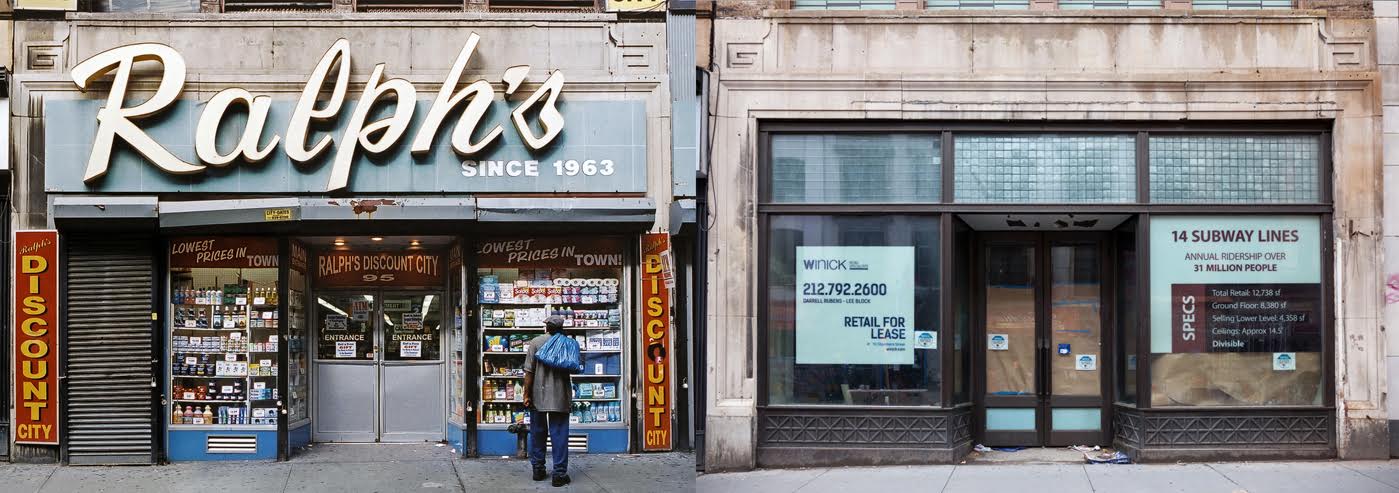
Ralph’s Discount City, which had been in business since 1963 and was one of the last inexpensive grocery/convenience stores in TriBeCa, closed in 2007 after the building was sold to a developer who planned to tear down the single-story building to make way for a 6-story luxury condo. Today, the condo project is finished but the retail space remains empty. Photo left 2004 / photo right 2014.
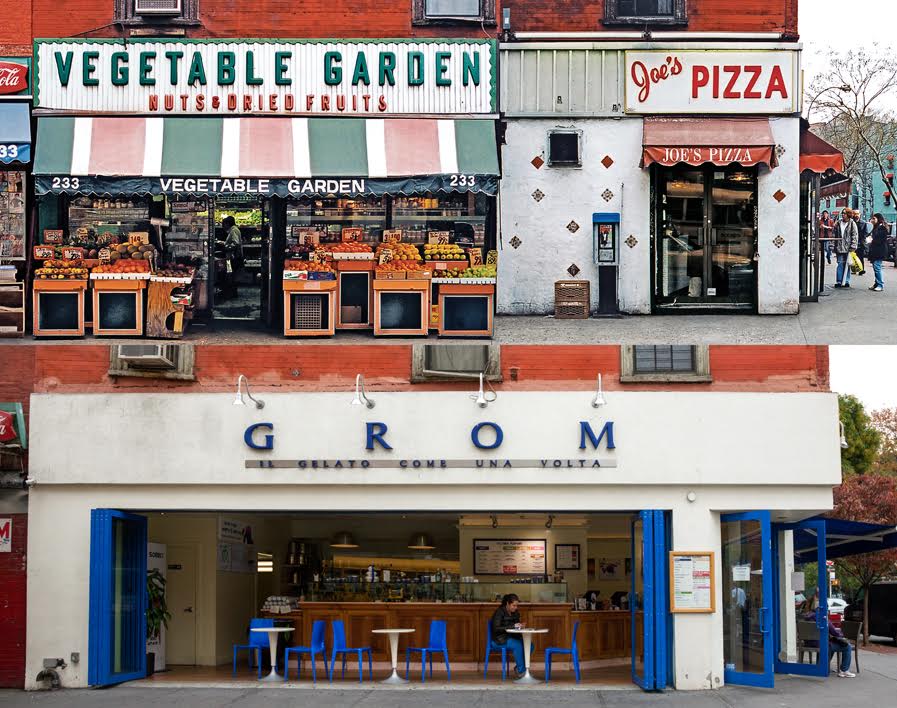
Joe’s Pizza on Bleecker Street was established in 1975 by Joe Pozzuoli, an immigrant from Naples, Italy. Joe served the classic New York slice and worked seven days a week alongside his sons until he was forced to leave to their corner storefront in 2005. The landlord had raised the rent and demanded a 1.5 million dollar guarantee for Joe Puzzuoli to stay in his original location, so he moved around the corner to Carmine Street. Grom, an upscale gelato store, took over both the Joe’s Pizza storefront as well as the neighboring Vegetable Garden storefront, a relic of what was once Greengrocer’s Row. Photo above 2001/ photo below 2014
See more of James and Karla Murray’s photos on their website. Buy their most recent book, Store Front II: A History Preserved here.
Related:
Incredible Photos by the First American Female War Correspondent
No Cameras Necessary: 8 Camera-Less Photographers You Need to Know




